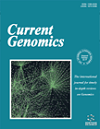- Home
- A-Z Publications
- Current Genomics
- Previous Issues
- Volume 13, Issue 7, 2012
Current Genomics - Volume 13, Issue 7, 2012
Volume 13, Issue 7, 2012
-
-
Genome-Scale Studies of Aging: Challenges and Opportunities
More LessAuthors: Mark A. McCormick and Brian K. KennedyWhole-genome studies involving a phenotype of interest are increasingly prevalent, in part due to a dramatic increase in speed at which many high throughput technologies can be performed coupled to simultaneous decreases in cost. This type of genome-scale methodology has been applied to the phenotype of lifespan, as well as to wholetranscriptome changes during the aging process or in mutants affecting aging. The value o Read More
-
-
-
Genome-Wide RNAi Longevity Screens in Caenorhabditis elegans
More LessAuthors: Melana E. Yanos, Christopher F. Bennett and Matt KaeberleinProgress in aging research has identified genetic and environmental factors that regulate longevity across species. The nematode worm Caenorhabditis elegans is a genetically tractable model system that has been widely used to investigate the molecular mechanisms of aging, and the development of RNA interference (RNAi) technology has provided a powerful tool for performing large-scale genetic screens in this Read More
-
-
-
Mitochondria and Organismal Longevity
More LessAuthors: Ara B. Hwang, Dae-Eun Jeong and Seung-Jae LeeMitochondria are essential for various biological processes including cellular energy production. The oxidative stress theory of aging proposes that mitochondria play key roles in aging by generating reactive oxygen species (ROS), which indiscriminately damage macromolecules and lead to an age-dependent decline in biological function. However, recent studies show that increased levels of ROS or inhibition of mitochondrial fu Read More
-
-
-
Chromatin Remodeling, DNA Damage Repair and Aging
More LessAuthors: Baohua Liu, Raymond K.H Yip and Zhongjun ZhouCells are constantly exposed to a variety of environmental and endogenous conditions causing DNA damage, which is detected and repaired by conserved DNA repair pathways to maintain genomic integrity. Chromatin remodeling is critical in this process, as the organization of eukaryotic DNA into compact chromatin presents a natural barrier to all DNA-related events. Studies on human premature aging syndromes togeth Read More
-
-
-
MicroRNA in Aging: From Discovery to Biology
More LessAuthors: Hwa Jin Jung and Yousin SuhMicroRNAs (miRNAs) are small non-coding RNA molecules that negatively regulate gene expression of their targets at the post-transcriptional levels. A single miRNA can target up to several hundred mRNAs, thus capable of significantly altering gene expression regulatory networks. In-depth study and characterization of miRNAs has elucidated their critical functions in development, homeostasis, and disease. A link betw Read More
-
-
-
Systems Biology in Aging: Linking the Old and the Young
More LessAging can be defined as a process of progressive decline in the physiological capacity of an organism, manifested by accumulated alteration and destabilization at the whole system level. Systems biology approaches offer a promising new perspective to examine the old problem of aging. We begin this review by introducing the concepts of systems biology, and then illustrate the application of systems biology approaches to ag Read More
-
-
-
Genetic Association Studies: An Information Content Perspective
More LessAuthors: Cen Wu, Shaoyu Li and Yuehua CuiThe availability of high-density single nucleotide polymorphisms (SNPs) data has made the human genetic association studies possible to identify common and rare variants underlying complex diseases in a genome-wide scale. A handful of novel genetic variants have been identified, which gives much hope and prospects for the future of genetic association studies. In this process, statistical and computational methods play Read More
-
-
-
On the Limitations of Biological Knowledge
More LessAuthors: Edward R. Dougherty and Ilya ShmulevichScientific knowledge is grounded in a particular epistemology and, owing to the requirements of that epistemology, possesses limitations. Some limitations are intrinsic, in the sense that they depend inherently on the nature of scientific knowledge; others are contingent, depending on the present state of knowledge, including technology. Understanding limitations facilitates scientific research because one can then recogniz Read More
-
Volumes & issues
-
Volume 26 (2025)
-
Volume 25 (2024)
-
Volume 24 (2023)
-
Volume 23 (2022)
-
Volume 22 (2021)
-
Volume 21 (2020)
-
Volume 20 (2019)
-
Volume 19 (2018)
-
Volume 18 (2017)
-
Volume 17 (2016)
-
Volume 16 (2015)
-
Volume 15 (2014)
-
Volume 14 (2013)
-
Volume 13 (2012)
-
Volume 12 (2011)
-
Volume 11 (2010)
-
Volume 10 (2009)
-
Volume 9 (2008)
-
Volume 8 (2007)
-
Volume 7 (2006)
-
Volume 6 (2005)
-
Volume 5 (2004)
-
Volume 4 (2003)
-
Volume 3 (2002)
-
Volume 2 (2001)
-
Volume 1 (2000)
Most Read This Month
Article
content/journals/cg
Journal
10
5
false
en


